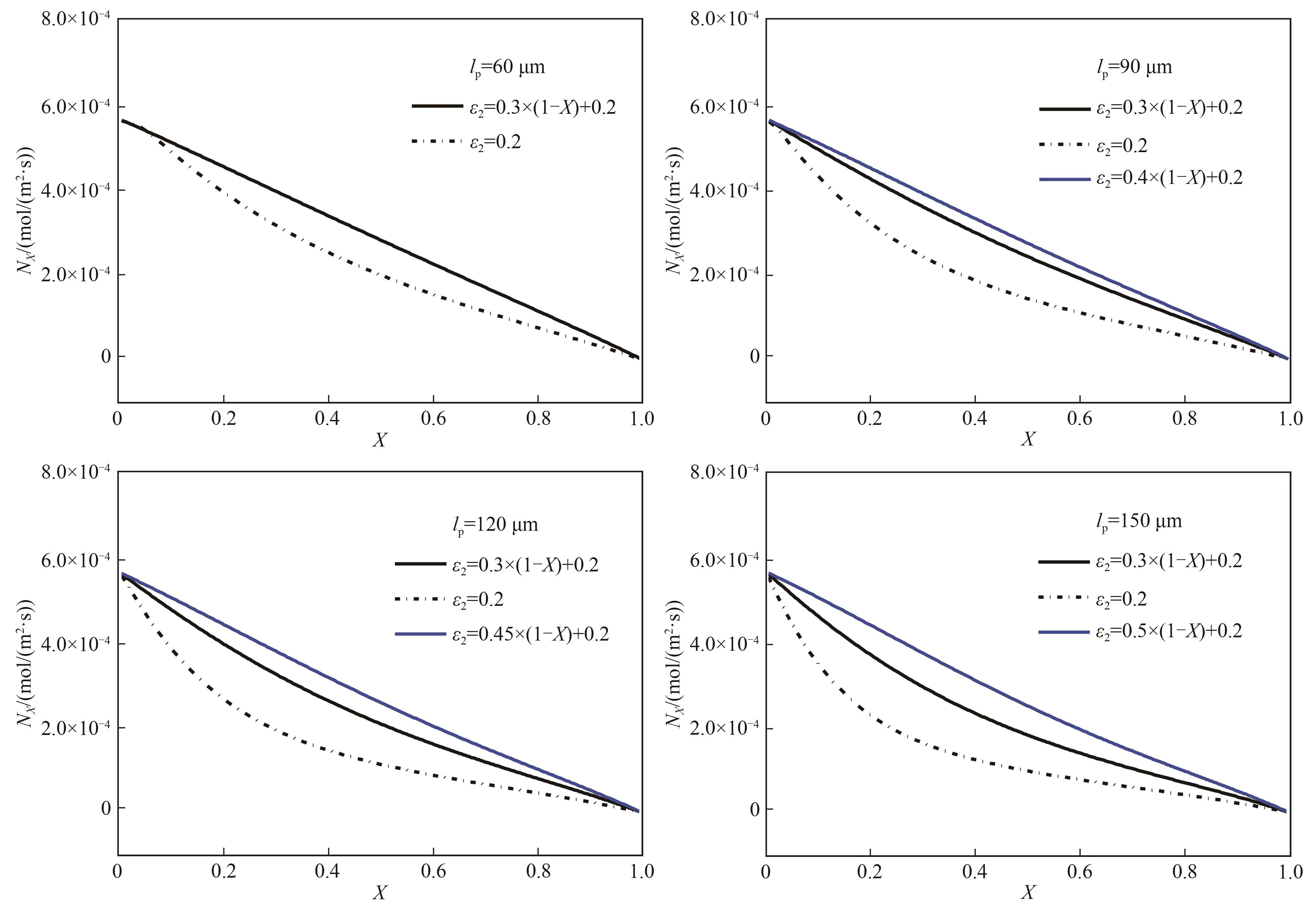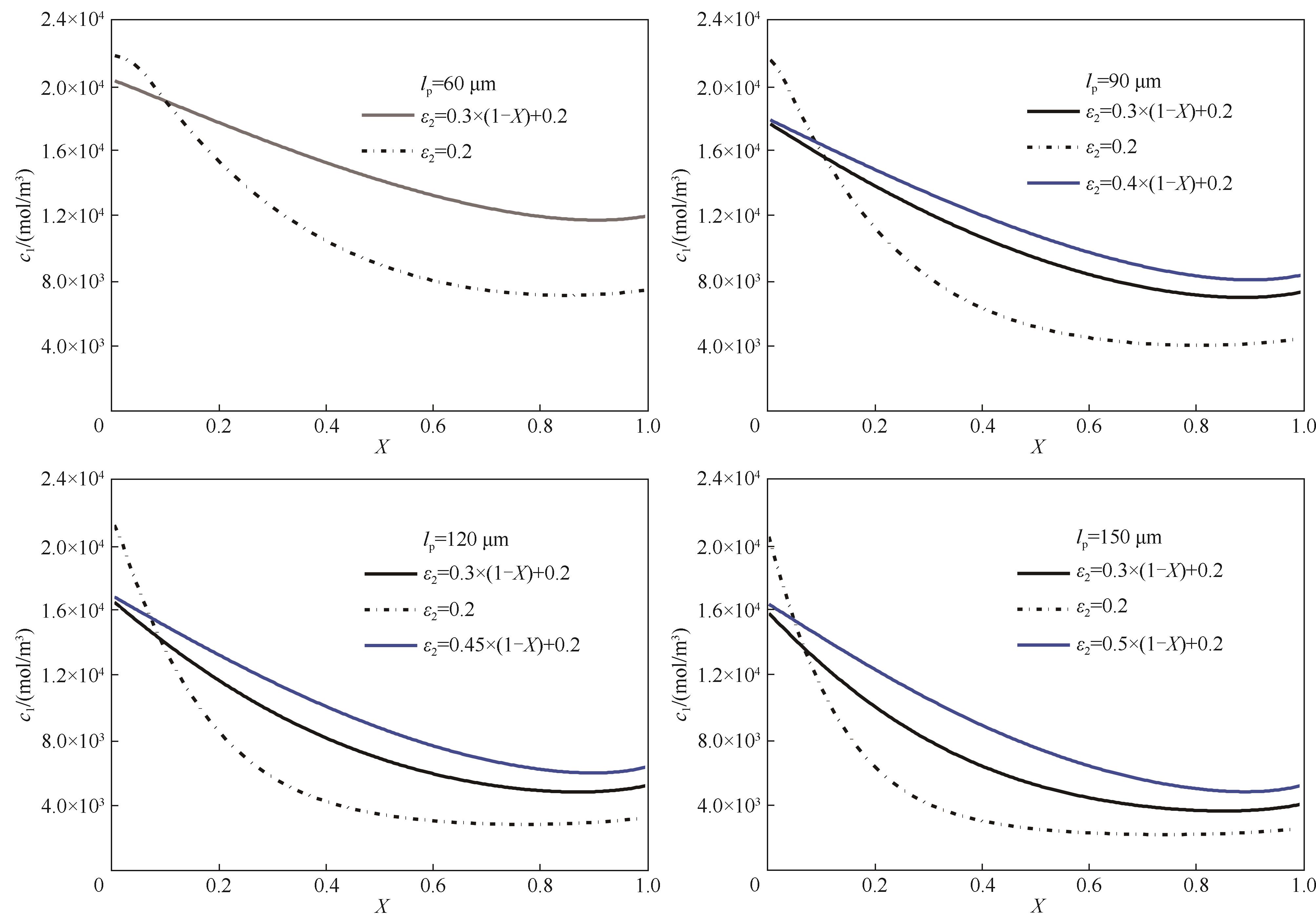CIESC Journal ›› 2022, Vol. 73 ›› Issue (1): 376-383.DOI: 10.11949/0438-1157.20210854
• Energy and environmental engineering • Previous Articles Next Articles
Huiyan WANG( ),Yiqin CHEN,Jinghong ZHOU(
),Yiqin CHEN,Jinghong ZHOU( ),Yueqiang CAO,Xinggui ZHOU
),Yueqiang CAO,Xinggui ZHOU
Received:2021-06-25
Revised:2021-10-09
Online:2022-01-18
Published:2022-01-05
Contact:
Jinghong ZHOU
通讯作者:
周静红
作者简介:王慧艳(1998—),女,硕士研究生,基金资助:CLC Number:
Huiyan WANG, Yiqin CHEN, Jinghong ZHOU, Yueqiang CAO, Xinggui ZHOU. Numerical simulation of cathode coating of lithium-ion battery for porosity optimization[J]. CIESC Journal, 2022, 73(1): 376-383.
王慧艳, 陈怡沁, 周静红, 曹约强, 周兴贵. 锂离子电池正极涂层孔隙结构优化的数值模拟[J]. 化工学报, 2022, 73(1): 376-383.
Add to citation manager EndNote|Ris|BibTeX

Fig.4 The comparison of energy density for lithium-ion batteries of different electrode thicknesses with uniform and gradient porosity under different discharge rates

Fig.5 The concentration distribution of lithium ion in the electrolyte(a) and metal lithium in active particles(b) for lithium-ion batteries with uniform porosity and gradient porosity under different discharge rates

Fig.6 The concentration distribution of lithium ion in the electrolyte for lithium-ion batteries with uniform porosity and gradient porosity at 4 C discharge rate under different electrode thickness

Fig.7 The concentration distribution of metal lithium in active particles for lithium-ion batteries with uniform porosity and gradient porosity at 4 C discharge rate under different electrode thicknesses
| 1 | Fan E S, Li L, Wang Z P, et al. Sustainable recycling technology for Li-ion batteries and beyond: challenges and future prospects[J]. Chemical Reviews, 2020, 120(14): 7020-7063. |
| 2 | Feng X N, Ouyang M G, Liu X, et al. Thermal runaway mechanism of lithium ion battery for electric vehicles: a review[J]. Energy Storage Materials, 2018, 10: 246-267. |
| 3 | Li Y C, Zhang Y P, Ma J J, et al. Synthesis of LiFePO4 nanocomposite with surface conductive phase by Zr doping with Li excess for fast discharging[J]. Journal of The Electrochemical Society, 2019, 166(2): A410-A415. |
| 4 | Wang D, Liu W H, Zhang X H, et al. Review of modified nickel-cobalt lithium aluminate cathode materials for lithium-ion batteries[J]. International Journal of Photoenergy, 2019, 2019(8): 1-13. |
| 5 | Zheng H H, Li J, Song X Y, et al. A comprehensive understanding of electrode thickness effects on the electrochemical performances of Li-ion battery cathodes[J]. Electrochimica Acta, 2012, 71: 258-265. |
| 6 | Suthar B, Northrop P W C, Rife D, et al. Effect of porosity, thickness and tortuosity on capacity fade of anode[J]. Journal of the Electrochemical Society, 2015, 162(9): A1708-A1717. |
| 7 | Antartis D, Dillon S, Chasiotis I. Effect of porosity on electrochemical and mechanical properties of composite Li-ion anodes[J]. Journal of Composite Materials, 2015, 69(15): 303-308. |
| 8 | Jo M, Hong Y S, Choo J, et al. Effect of LiCoO2 cathode nanoparticle size on high rate performance for Li-ion batteries[J]. Journal of the Electrochemical Society, 2009, 156(6): A430-A434. |
| 9 | Srinivasan V, Newman J. Design and optimization of a natural graphite/iron phosphate lithium-ion cell[J]. Journal of the Electrochemical Society, 2004, 151(10): A1530. |
| 10 | Cobb C L, Solberg S E. Communication—analysis of thick co-extruded cathodes for higher-energy-and-power lithium-ion batteries[J]. Journal of the Electrochemical Society, 2017, 164(7): A1339-A1341. |
| 11 | 许于, 陈怡沁, 周静红, 等. LiFePO4锂离子电池的数值模拟: 正极材料颗粒粒径的影响[J]. 化工学报, 2020, 71(2): 821-830. |
| Xu Y, Chen Y Q, Zhou J H, et al. Numerical simulation of lithium-ion battery with LiFePO4 as cathode material: effect of particle size[J]. CIESC Journal, 2020, 71(2): 821-830. | |
| 12 | 陈怡沁, 许于, 周静红, 等. 锂离子电池异构建模及内部传质机理探究: 粒径分布的影响[J]. 化工学报, 2021, 72(2): 1078-1088. |
| Chen Y Q, Xu Y, Zhou J H, et al. Heterogeneous modeling and internal mass transfer mechanism of lithium-ion batteries: effect of particle size distribution[J]. CIESC Journal, 2021, 72(2): 1078-1088. | |
| 13 | Yamazaki A, Orikasa Y, Chen K, et al. In-situ measurement of the lithium distribution in Li-ion batteries using micro-IBA techniques[J]. Nuclear Instruments and Methods in Physics Research Section B: Beam Interactions With Materials and Atoms, 2016, 371: 298-302. |
| 14 | 查全性. 电极过程动力学导论[M]. 3版. 北京: 科学出版社, 2002. |
| Zha Q X. Introduction to Electrode Process Dynamics[M]. 3rd ed. Beijing: Science Press, 2002. | |
| 15 | Park J, Hyeon S, Jeong S, et al. Performance enhancement of Li-ion battery by laser structuring of thick electrode with low porosity[J]. Journal of Industrial and Engineering Chemistry, 2019, 70: 178-185. |
| 16 | Wang C P, Lopatin S D, Bachrach R Z, et al. Graded electrode technologies for high energy lithium-ion batteries: US20110168550[P]. 2011-07-14. |
| 17 | Wang B C, Hong Y F, Wang L, et al. Development and numerical investigation of novel gradient-porous heat sinks[J]. Energy Conversion and Management, 2015, 106: 1370-1378. |
| 18 | Qin J, Zhou X, Zhao C Y, et al. Numerical investigation on boiling mechanism in porous metals by LBM at pore scale level[J]. International Journal of Thermal Sciences, 2018, 130: 298-312. |
| 19 | Pompe W, Worch H, Epple M, et al. Functionally graded materials for biomedical applications[J]. Materials Science and Engineering: A, 2003, 362(1/2): 40-60. |
| 20 | Biesheuvel P M, Breedveld V, Higler A P, et al. Graded membrane supports produced by centrifugal casting of a slightly polydisperse suspension[J]. Chemical Engineering Science, 2001, 56(11): 3517-3525. |
| 21 | Yang J L, Yang L J, Xu C, et al. Numerical analysis on thermal behavior of solid-liquid phase change within copper foam with varying porosity[J]. International Journal of Heat and Mass Transfer, 2015, 84: 1008-1018. |
| 22 | Jeong J, Lee H, Choi J, et al. Effect of LiFePO4 cathode density and thickness on electrochemical performance of lithium metal polymer batteries prepared by in situ thermal polymerization[J]. Electrochimica Acta, 2015, 154: 149-156. |
| 23 | 赵丰刚, 陈治, 汪颖, 等. 具有良好电化学性能的厚电极及其制备方法: 102324493B[P]. 2016-03-30. |
| Zhao F G, Chen Z, Wang Y, et al. Thick electrode with good electrochemical performance and its preparation method: 102324493B[P]. 2016-03-30. | |
| 24 | 杨续来, 张峥, 曹勇, 等. 高能量密度锂离子电池结构工程化技术探讨[J]. 储能科学与技术, 2020, 9(4): 1127-1136. |
| Yang X L, Zhang Z, Cao Y, et al. The structural engineering for achieving high energy density Li-ion batteries[J]. Energy Storage Science and Technology, 2020, 9(4): 1127-1136. | |
| 25 | Singh M, Kaiser J, Hahn H. A systematic study of thick electrodes for high energy lithium ion batteries[J]. Journal of Electroanalytical Chemistry, 2016, 782: 245-249. |
| [1] | Fei KANG, Weiguang LYU, Feng JU, Zhi SUN. Research on discharge path and evaluation of spent lithium-ion batteries [J]. CIESC Journal, 2023, 74(9): 3903-3911. |
| [2] | Guoze CHEN, Dong WEI, Qian GUO, Zhiping XIANG. Optimal power point optimization method for aluminum-air batteries under load tracking condition [J]. CIESC Journal, 2023, 74(8): 3533-3542. |
| [3] | Zhilong WANG, Ye YANG, Zhenzhen ZHAO, Tao TIAN, Tong ZHAO, Yahui CUI. Influence of mixing time and sequence on the dispersion properties of the cathode slurry of lithium-ion battery [J]. CIESC Journal, 2023, 74(7): 3127-3138. |
| [4] | Zhaoguang CHEN, Yuxiang JIA, Meng WANG. Modeling neutralization dialysis desalination driven by low concentration waste acid and its validation [J]. CIESC Journal, 2023, 74(6): 2486-2494. |
| [5] | Laiming LUO, Jin ZHANG, Zhibin GUO, Haining WANG, Shanfu LU, Yan XIANG. Simulation and experiment of high temperature polymer electrolyte membrane fuel cells stack in the 1—5 kW range [J]. CIESC Journal, 2023, 74(4): 1724-1734. |
| [6] | Weijiang CHENG, Heqi WANG, Xiang GAO, Na LI, Sainan MA. Research progress on film-forming electrolyte additives for Si-based lithium-ion batteries [J]. CIESC Journal, 2023, 74(2): 571-584. |
| [7] | Jianglong DU, Wenqi YANG, Kai HUANG, Cheng LIAN, Honglai LIU. Heat dissipation performance of the module combined CPCM with air cooling for lithium-ion batteries [J]. CIESC Journal, 2023, 74(2): 674-689. |
| [8] | Lei ZHONG, Xueqing QIU, Wenli ZHANG. Advances in lignin-derived carbon anodes for alkali metal ion batteries [J]. CIESC Journal, 2022, 73(8): 3369-3380. |
| [9] | Yifang DONG, Yingying YU, Xuegong HU, Gang PEI. Electric field effect on wetting and capillary flow characteristics in vertical microgrooves [J]. CIESC Journal, 2022, 73(7): 2952-2961. |
| [10] | Ziyi CHI, Chengwei LIU, Yuling ZHANG, Xuegang LI, Wende XIAO. Reactor simulation and optimization for CO oxidative coupling to dimethyl oxalate reactions [J]. CIESC Journal, 2022, 73(11): 4974-4986. |
| [11] | Xi ZHENG, Tao WANG, Yongsheng REN, Zhenzhen ZHAO, Xueqi WANG, Zhiping ZHAO. Preparation and properties research of poly(m-phenylene isophthalamide) flat-sheet membrane [J]. CIESC Journal, 2022, 73(10): 4707-4721. |
| [12] | JIANG Jiatong, HU Bin, WANG Ruzhu, LIU Hua, ZHANG Zhiping, LI Hongbo. Dynamic simulation of horizontal condenser of R1233zd(E) high temperature heat pump [J]. CIESC Journal, 2021, 72(S1): 98-105. |
| [13] | LIANG Kunfeng, WANG Moran, GAO Meijie, LYU Zhenwei, XU Hongyu, DONG Bin, GAO Fengling. Thermodynamic analysis of performance of integrated thermal management system for pure electric vehicle [J]. CIESC Journal, 2021, 72(S1): 494-502. |
| [14] | Yuanxin FANG, Wu XIAO, Xiaobin JIANG, Xiangcun LI, Gaohong HE, Xuemei WU. Process design and simulation of membrane separation coupled with CO2 electrocatalytic hydrogenation to formic acid [J]. CIESC Journal, 2021, 72(9): 4740-4749. |
| [15] | Xuming LIANG, Yongchao SHEN, Dong WEI, Qian GUO, Zhi GAO. Analysis of output characteristics of aluminum-air battery based on DC internal resistance and AC impedance characteristics [J]. CIESC Journal, 2021, 72(8): 4361-4370. |
| Viewed | ||||||
|
Full text |
|
|||||
|
Abstract |
|
|||||